G4 Chain and gear chart 2019
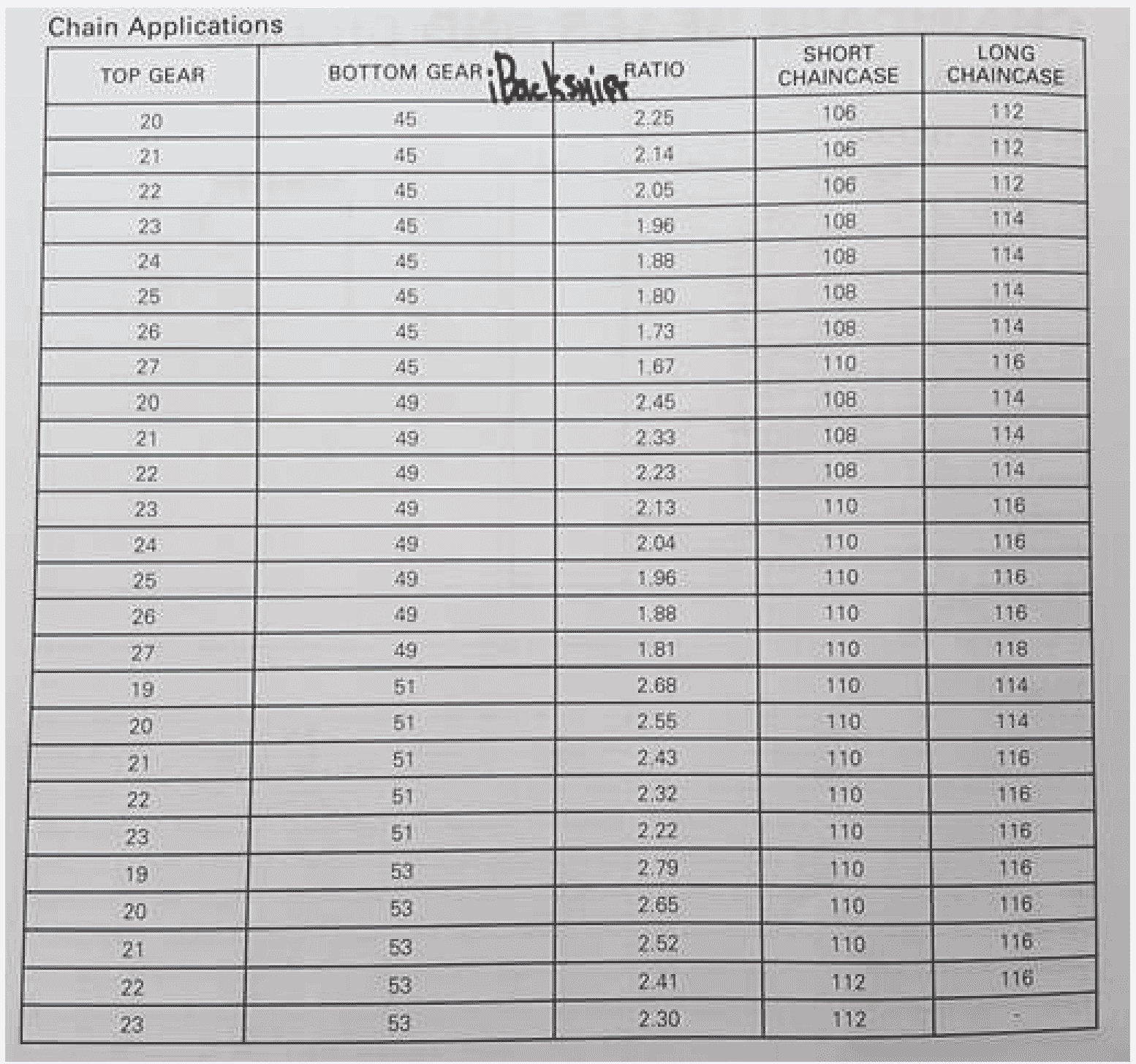
Gearing – Mountain Specific
If you ever want to regear, it’s not a problem with this kit to go any of these ratios, in fact my helix’s work so well with lower gearing for whatever track speed you achieve, it will maintain it with great strength. Lower gear; even stronger track speed holding power.
XP/XM Chassis
21:49 = 2.33 = 104P
19:45 = 2.36 = 102P
21:51 = 2.42 = 106P
20:49 = 2.45 = 104P
20:51 = 2.55 = 106P
19:49 = 2.57 = 104P
19:51 = 2.68 = 106P
Rev chassis
19:45 = 2.36
19:46 = 2.42
19:47 = 2.47
19:50 = 2.63
19:51 = 2.68
……..ahh, geez, I gotta update these for the latest T3 and G4 sleds.
Gearing – Summit 800etec over revving on road
Larry writes) I am running 21.5 grams of weight, on clicker 3, stock gearing, 20XX 800etec 154″ summit.
Testing was done on hardpack trail, initial rpm’s WOT 7900, held the wot and started climbing in rpms after a period of time, until hitting the rev limiter. 1200 feet altitude, I was not able to get top speed reading.
A couple of questions: 1] Normal operation is not trail use, so I would not hold it WOT like I did for testing. It took quite a while for rpms to start increasing under WOT. All short WOT operation, small hills, midwest riding in UP of Michigan.
2] Should I be testing in off trail conditions?
Moe writes) Hardpack is fine for going for a ride to see if there are any bugs or anything was installed incorrectly or needs to be adjusted.
The clutching is designed for getting more track speed in deep snow when breaking fresh snow and enhancing the backshift strength. Breaking fresh snow, backshift much stronger and able to maintain full throttle in deep snow and have correct engine speed for long periods of time. Continuous cycling of throttle with strong recovery.
Your sled is geared @ 19:49 so lets find out how fast the theoretical vehicle speed will be.
Far as going out on hardpack you’ll end up finding out what top end is real quick and when the clutches shift out the engine takes off into overrev.
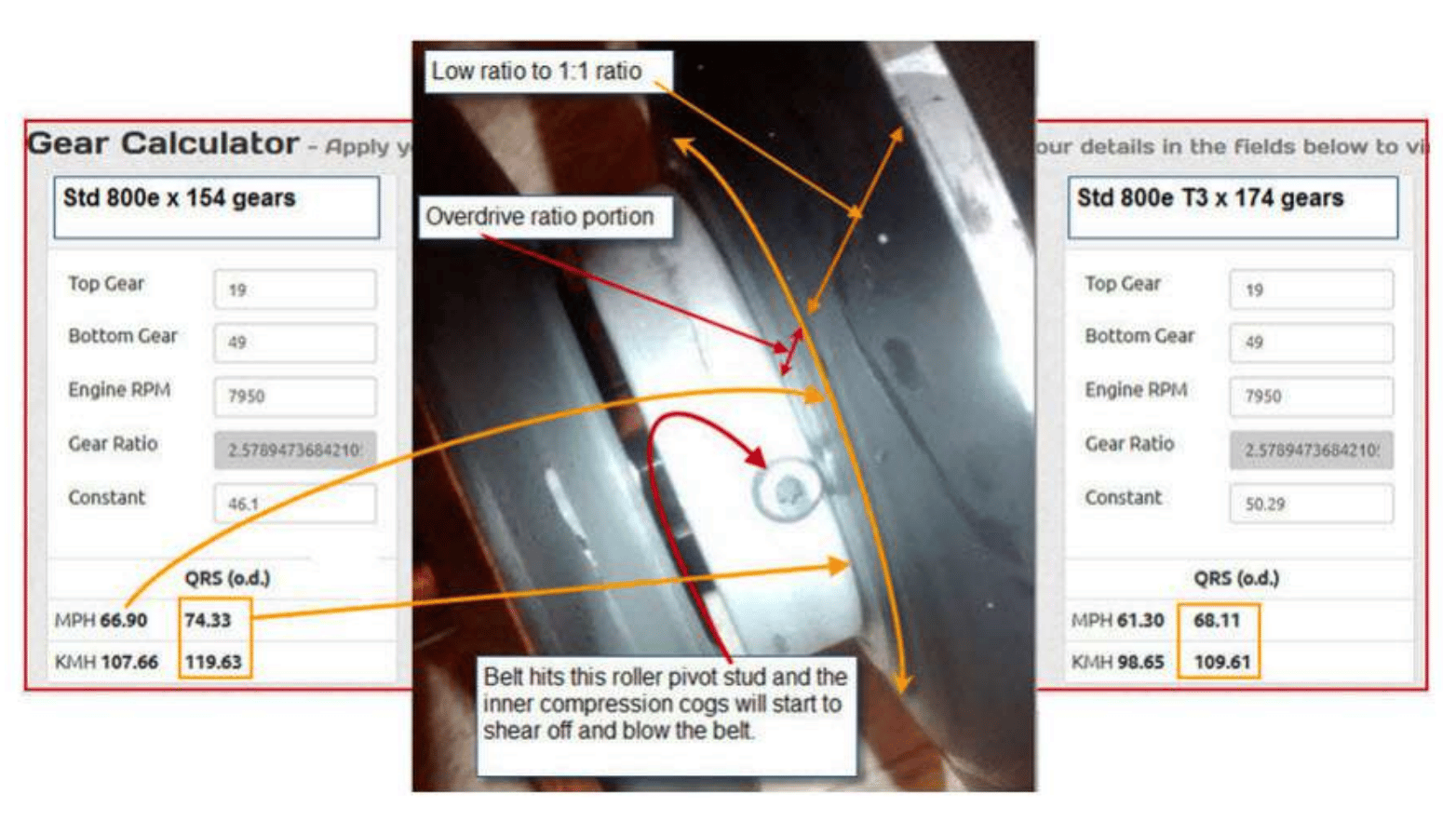
Sledders talk about overreving their lower geared sleds….
Questions to ask) When you hit the throttle from a dead stop, does the engine go to 84~8500 right away (yes or no)
IF no, then what engine speed does the tach go to when you punch the throttle?
When you are traveling along part throttle at 30~40mph and hit the throttle full, does the engine go to 84~8500 right away (yes or no)
IF no, then what engine speed does the tach go to when you punch the throttle?
What vehicle speed does the engine start to go past its rated engine speed? Comment – what we are looking for is “When does the engine overrev?” Right away in 10 feet or like 400 feet or more?
Next question – Is there any speed from 0kmh to 60mph that is less than 8500? Yes or no? To prove the clutch shifted out and cannot stroke anymore – Go prove this yourself – Take a felt marker and mark the primary clutch.
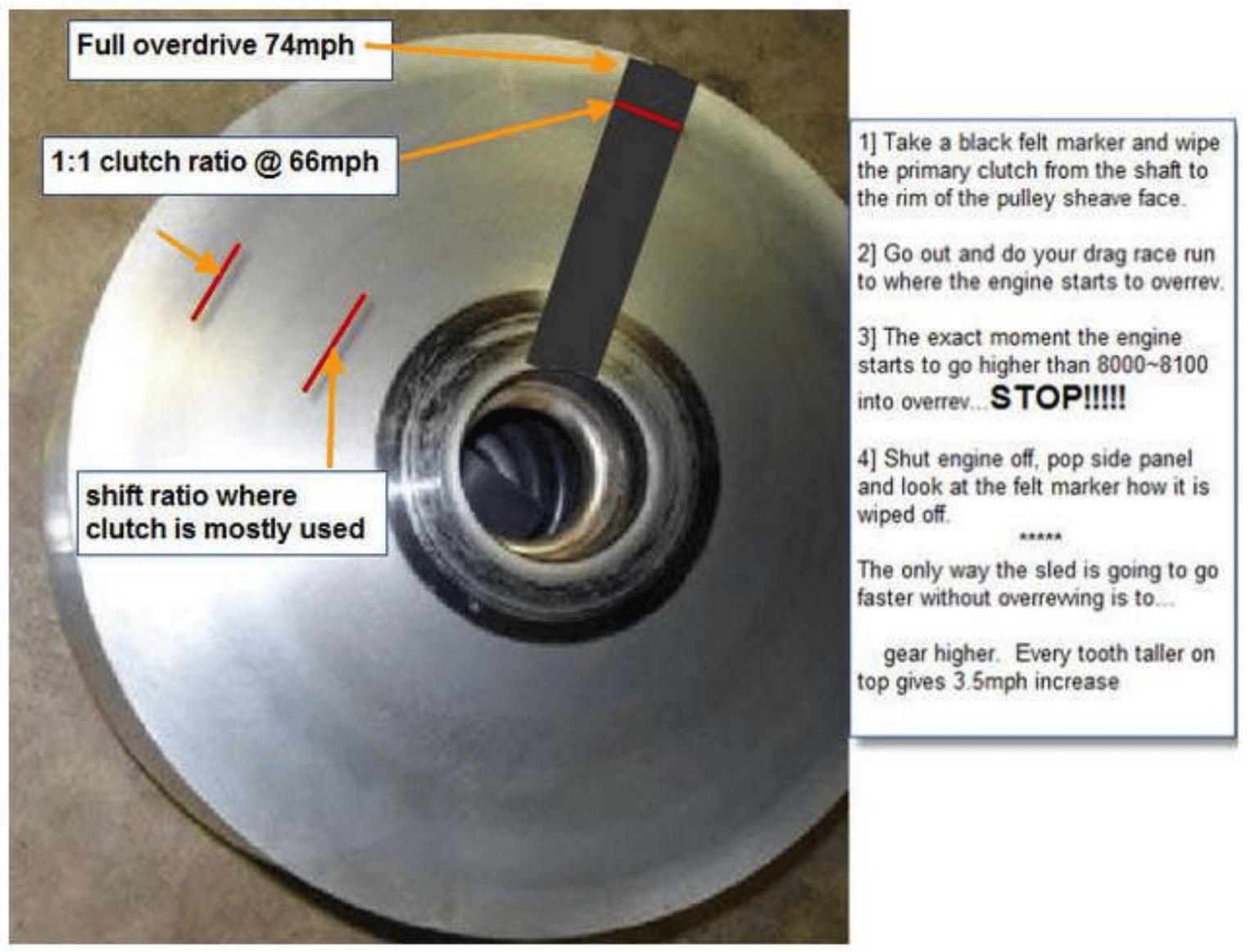
Now go take your full throttle run and watch the tachometer. 7900~8000~7900….and then eventually it starts to go over 8000 – STOP!
Pop the side panel and look where the felt marker was wiped off and now you have proof that you are expecting more out of your gear ratio than what your sled has for maximum speed.
Once the clutch achieves overdrive and stops stroking then…Adding flyweight is not going to stop overrevving from 8000 to 8500. Lowering the clicker is not going to stop overrevving from 8000 to 8500.
The only way you will stop the overrev at the speed its been overrevving is to….
Gear up. 1 tooth will increase about 3.5mph theoretical top end.
Put the sled on the back of a truck
Falling off a cliff. haha
Gearing – Change track from 1.25 to 1.75
Question) Hi I was wondering if it would be better to go down two top gear teeth when taking out my 1.25” track and putting in a 1.75 on a xp 600 carburetor. Does the little 600 carb have enough power without breaking belts to turn the 1.75 when you get into deeper snow?
I don’t want to lose all the top end speed but I love playing in powder. When I ride with my father it’s 80mph all-day and don’t want to be W.O.T. all-day.
Answer) For every 1/4″ increase of track lug height you could be gearing down at least 1 tooth on an 800. On a 600 you can go 2 teeth down for every 1/4″ of lug height increase.
2010 600 Carb gearing should be 25:45 with original 1.25 track.
The latest 600 Rene’ BCX’s geared at 21:49 (equivalent gear to 19:45 gears)
Going to the 120×1.75 track, I would at least run a 21 top gear with a 104P chain. This is an important question(s) for any tuner – its right at the top of questions when changing a track lug size.
Question on top speed – what is the highest most reasonable peak vehicle speed you want to achieve with the new “X” size lug track? Be sensible about the peak speed.
Question – time at top speed – How much time do you spend at your highest vehicle speed chosen? (When I say high, I mean from 3/4 speed to full speed of this potential vehicle speed you are being sensible about) Is the time several seconds? Just a quick shot to top end? Several seconds? 30 or more?
Keep in mind the engine power you have. A carburetor 600 is about 104~106hp and want to push a 1.75 track to 90+mph on GPS or Radar? Going that fast is going to be difficult to uphold. I’m not talking speedometer, rather talking GPS speed measurement.
There are 2 significant clutch ratio lines inside the clutches. First is 1:1 clutch ratio. The engine speed is the same as secondary shaft speed. 1:1 clutch ratio is roughly 3/4 of an inch from the rim of the primary. Second is the outer rim of the primary. From ¾ of an inch to the rim of the primary clutch, that is where the secondary shaft speed continuously increases speed over engine speed. The secondary shaft can turn up to 17% faster than the engine. (Difficult to tune in this range)
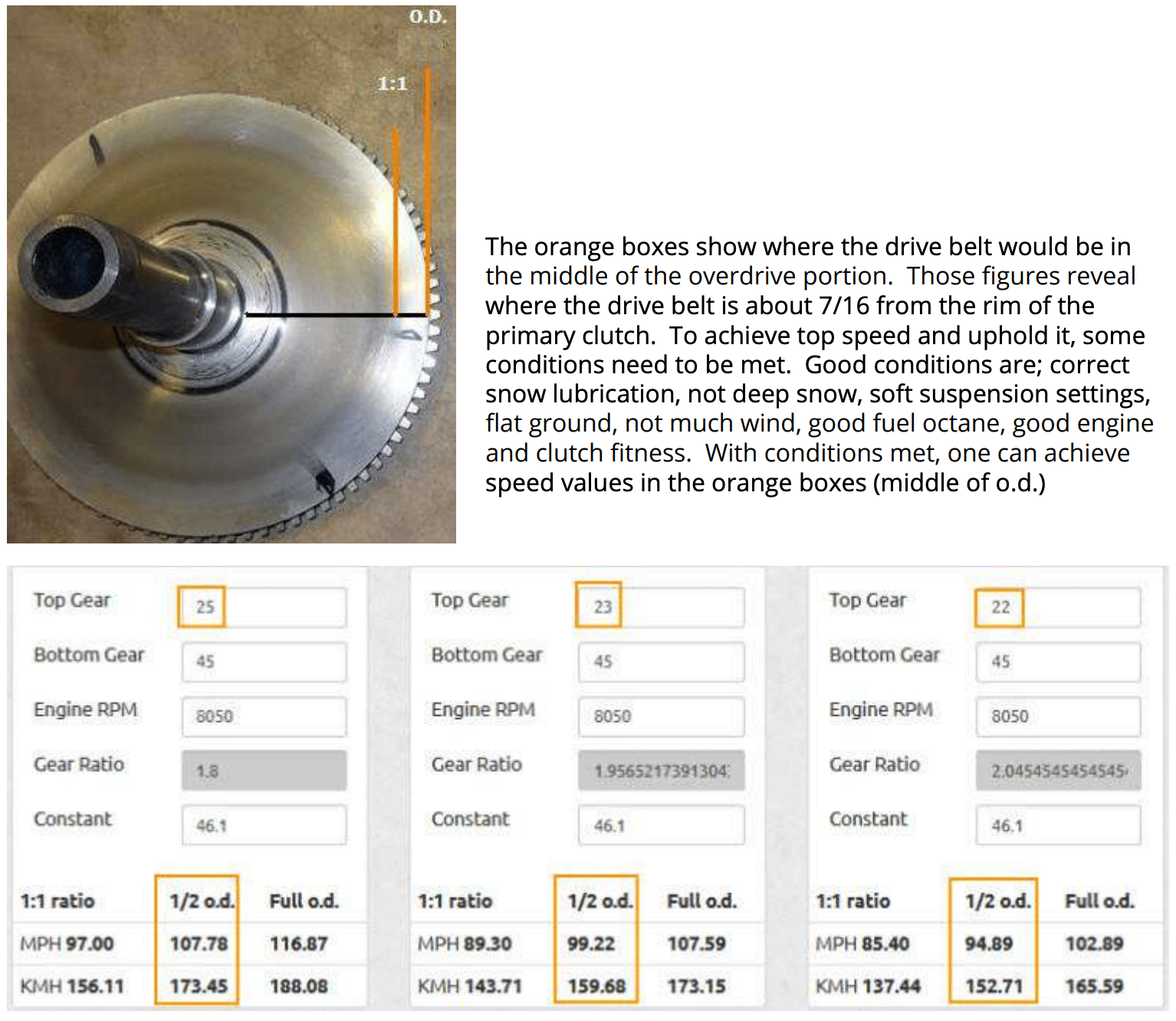
Gearing – Changed from 20 to 18 tooth and lost engine speed
Matt writes) Trail clutch kit for my 06 MXZ x 600sdi. I re-geared to a 20-46, 1.75 track.
It is amazing the difference. I can beat most stock 800s to 80.
Lowered gears even further to 18-45
Comes out of the hole crazy fast, gained a bit top end speed.
Powder it hits 8000 then drops to 7000 and picks back up if I stay in the throttle.
Before I go back to the 20-46 gear set up is there anything I can do to leave that gear set up in? Like a ramp change or something.
Joe writes) What you can do is learn more about what gearing does in effect to the workings of the primary clutch. One thing you will find from gearing down a substantial amount to measure, and I don’t mean one tooth, I mean two teeth or more will make a substantial difference that you can feel in the seat-o-pants…
…The effect gearing down has on flyweight- Gearing down gives flyweight the motive to act like a heavier mass than previous gear. The fact is the Center of Gravity (hereinafter CofG) of the flyweight is now at a farther relative position away from the clutch shaft centerline per mph/shift position on the shift curve.
For lack of better numbers lets use 90mph and pick the difference between 18 gear and 20 top gear. *Where is the belt centerline on the primary clutch face at this steady mph?
At previous gearing [20] the belt centerline and the CofG position of the TRA arm is lower and closer to the clutch shaft or if you like..the engagement position. When depressing the fuel to accelerate, you’ll find the engine will shift at whatever rpm and peak at the proper rpms.
With the newer lower gear [18] the belt centerline and the CofG position of the TRA arm is higher and farther away from the clutch shaft or if you like..the engagement position.
NOTE – IN THE PICTURE LOOK WHERE THE BELT IS NOW WITH THE 18 GEAR(RIGHT) VS. 20 GEAR(LEFT)
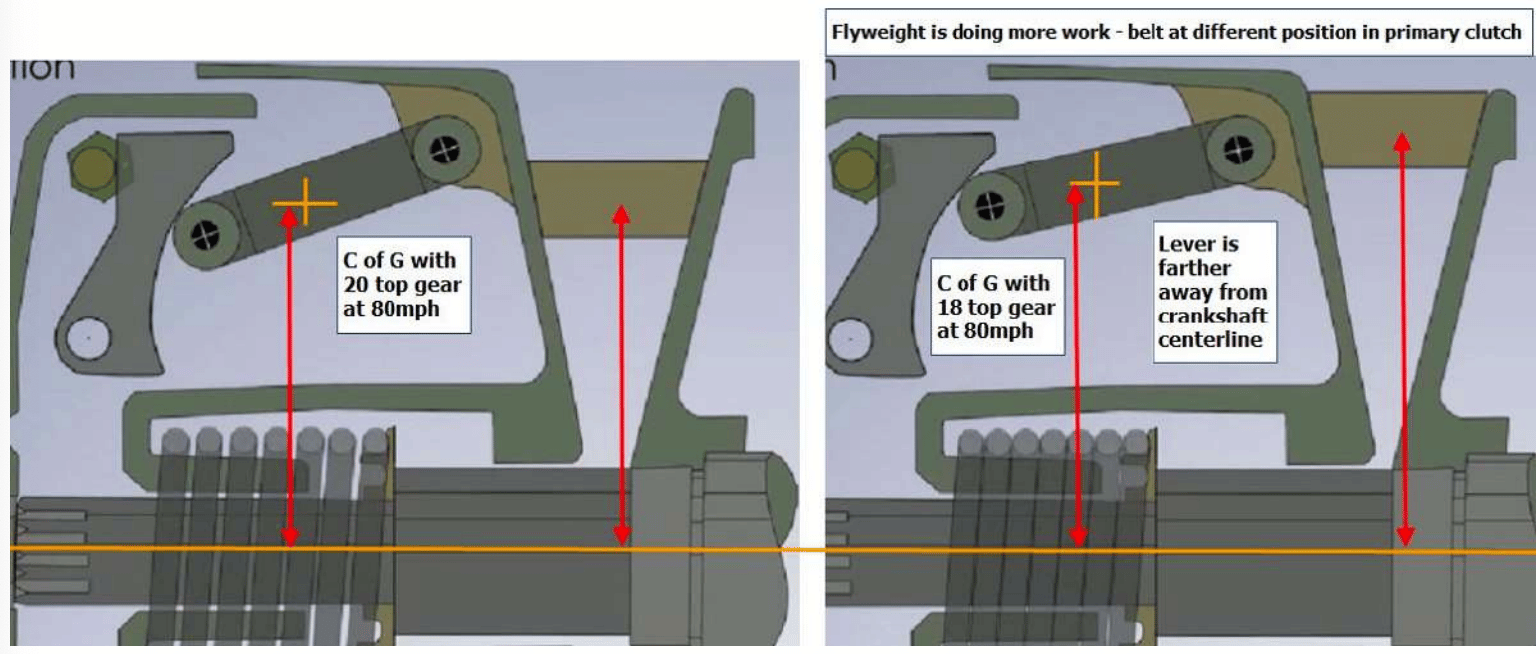
When pressing the throttle to accelerate, you’ll find the engine will shift at a lower rpm than the 20 gear and the peak rpm will be slightly less than proper rpms. You could lose 100 rpm or more because the weight is heavier and pushing harder at the 90mph speed.
Now there are a few advantages to this. From rest, as the sled speed increases, what inevitably follows is the flyweight does more work. The primary will capture slightly more the “meat” of the torque curve, especially on trail where you are on and off the throttle. The flyweight is taking advantage of a cooler exh pipe which some know that a cooler pipe makes more torque at lower midrange rpms.
NOTE: WHEN GEARING DOWN THE LEVER WILL BE IN A HIGHER POSITION ON THE RAMP – DOING MORE WORK AND ENGINE SPEED LOSS MAY RESULT – and can cure with a spring end force change.
I always get nearly the same comments that tuners can get a higher mph cresting the top of a hill and holding the skis in the air longer up hills. More torque going over the hill and especially when letting off the throttle to go thru the bottom safely, they ascend back up another hll, the engine is right there, responsive with improvement to get to peak rpms.
And nearly always recording the same top speeds on hardpack light loaded road conditions.
Clutch kit specs
Ramps – 410
Primary spring – 200/350
Secondary spring – 231/303
Matt writes) Powder it hits 8000 then drops to 7000 and picks back up if I stay in the throttle.
Joe writes) Aaen says IF engine speed drops towards top end speed, THEN raise primary spring end force.
Take the primary spring end force and raise it. Go from the 200/350 to a 200/380. That will raise engine speed where you were losing down to 7000 rpms.
There are no other springs from BRP that have a start at 200 with a higher finish than 380.
The next spring is the straightlineperformance.com BLUE 190/420 or the RED 220/420
If you do not want to source those springs you can also raise the finish force in the secondary spring
The Dalton Yellow/Orange 225/330 is a good choice too.
So if you still have fluctuating engine speed with the 200/380 primary spring
Then can change to a higher final force primary spring
OR
Leave the 200/380 in the primary and add the secondary spring with a higher end force 225/330 as mentioned.
Thanks, joey
Is G4 x 850 summit 19:45 lower gearing? Isn’t that too low?
Terje from Norway) My 850 154 has the high elevations ramps and that wrong for Norway. I don’t know why BRP send that over here. 19:45 is lower gearing? Isn’t that too low? I see it so many that are using 21/45 or 20/45, is that the wrong way to go?
Joey) Hi Terje. I have 19:45 stock in my 154 x 3”. I will be going lower gearing because I don’t care about top speed.
http://www.dootalk.com/forums/topic/1432146-2018-clutch-changes/?p=19656898
Terje) I see that. I don’t care about the top speed same as you. But isn’t it better to gear up so the belt will work at the most effective place in the clutch?
Joey) Ok…Please tell me where is the most effective place in the clutch?
Terje) I don’t know, just heard it from different places they work with clutch, so i just ask you to hear what you said about that. I have heard so much good about you and the kit so i want to try that this season. I just want to learn more about the clutching so then i ask??
Joey) Tell me what you do with the sled? Tree rider? Long pulls? Trail riding?
What is the maximum vehicle speed you do with the sled?
Terje) Drive most tree riding, uphill, want it to be quick up and downshift . Not drive so fast, maybe 80-90 km/h on the trail
Joey) @most effective place in the clutch
As the belt shifts out in the primary clutch, the track speed increases. As the belt shifts out in the primary clutch, the belt drops lower into the secondary clutch. As the belt speed and track speed increase the belt turns a bigger radius in the primary clutch and smaller radius in the secondary clutch. The secondary clutch rpm will eventually speed up and match the primary clutch rpms. When the two pulleys achieve the same speed they are at 1:1 ratio (example 7900 rpms primary clutch and 7900 rpms secondary clutch)
Olav Aaen says the most efficient range the belt position is, is “at” or “closest to” 1:1 and not over 1:1 into overdrive.
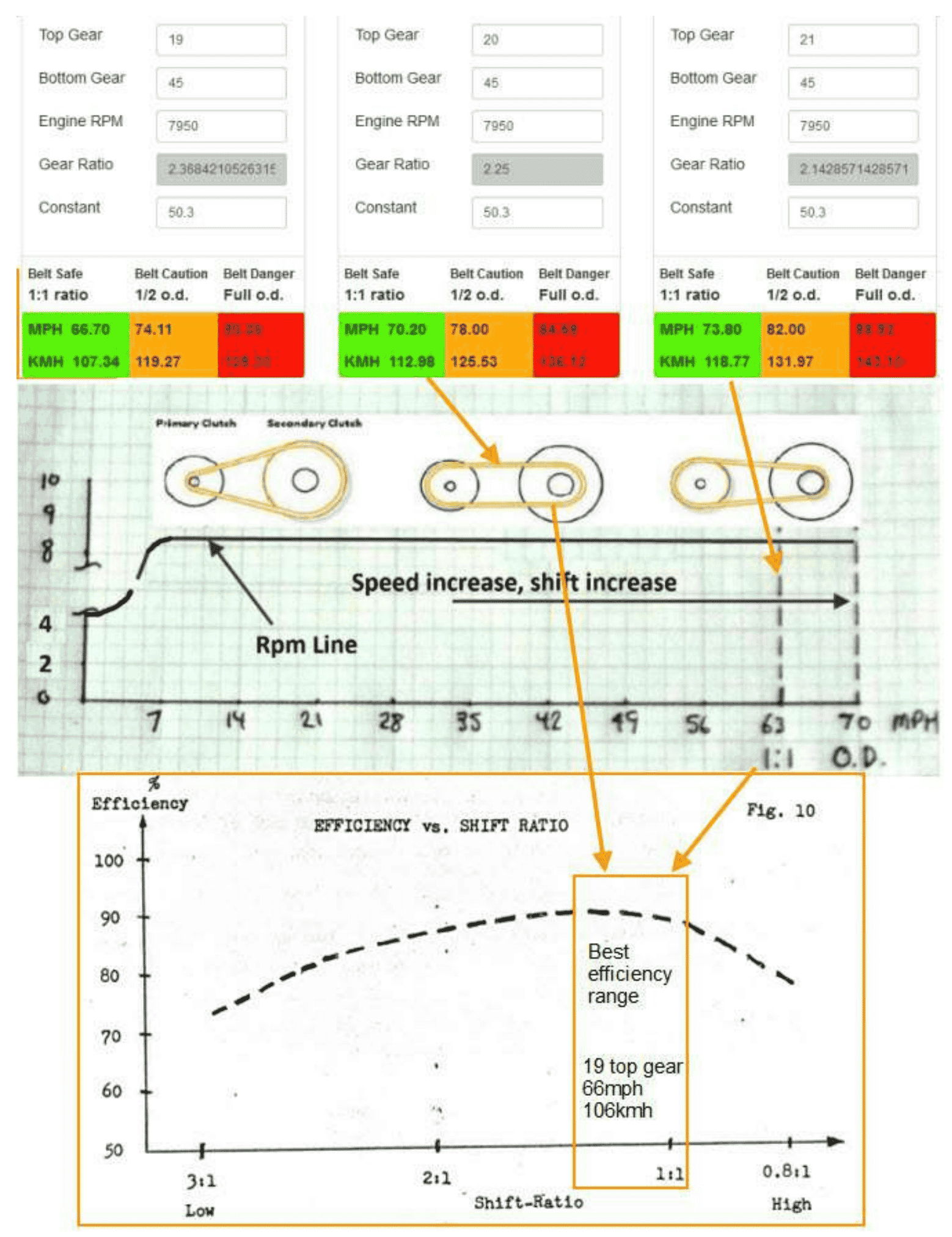
Terje) Drive most tree riding, uphill, want it to be quick up and downshift . Not drive so fast, maybe 80-90 km/h on the trail
Terje) most effective place in the clutch
Joey) Boxes A, B show gears lower than your 19:45. Boxes C, D show gears higher than your 19:45
Question – which box of A, B, C, D will get the drive belt and into the more “efficient” or as you say “most effective” place in the clutch at a lower track speed when you are…
“Tree riding”
“uphill” and
“quick up and backshift”?
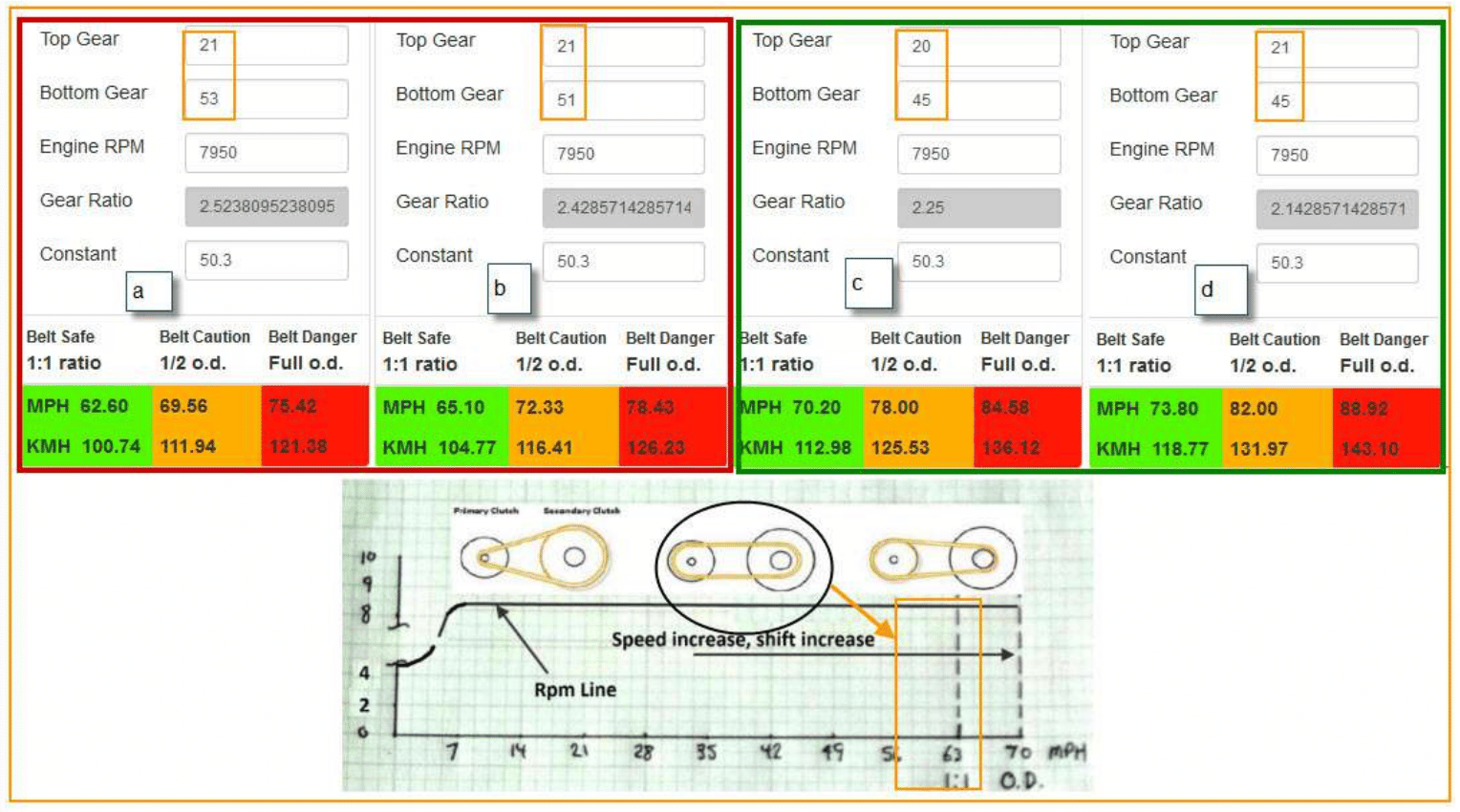
Where you run a deeper lug track and the sled runs quick and fast on hard pack and bumpy trail, (Some best mountain riding locations you have to run much hard pack) however you are on the hard pack and quickly pull off into untracked powder, keeping full throttle, looking to see 7900~8000 rpms (800etec) but the track speed reduces rather sharply. Aaen says a good setup should not vary more than 250 rpms and recover.
When you feel that sharp drop in 1) track speed and 2) sled speed in the deep snow, then you have to ask (I won’t use the words [ low enough ]) rather, “am I geared correctly to maximize my application?”
IF the top gear is too big, THEN the sharper the acceleration stops, achieving equilibrium (your current max track speed) even though upholding your rated rpms.
The lower you gear, then the more the belt will travel across the sheave face surface, (not the whole sheave surface; just a little more of it) the belt will use a little more of the sheave face, thus extracting heat away and allowing you to maximize the engine power speeding up the sled through the deep snow.
With lower gearing, you should feel the acceleration not dropping quickly. Rather being the sled feels eager, having an appetite for more snow, more full throttle without starting to smell excessive belt stench come out from underneath the hood.
Remember this – it is NOT using the whole sheave face, no.
Aaen says “gear as high as you can until you lose acceleration”.
Question – where are you losing acceleration?
Answer – I’m getting 42mph track speed and then suddenly, 36mph and engine speed drops 500 rpm, suddenly, severely and I have to slow down turn out to gain track speed again at full throttle.
Sometimes one is geared too high, not using enough sheave. Ok, gear a little lower to “use more sheave face” so the drive belt will go into a lower position in the drive pulley to be ready for you to crack the throttle again. Eventually you will select the “highest gear ratio” possible for your own clutching/location/snow type/driver input and style etc.
Whether the highest gear set is 19:45, 20:45, 21:45, 19:49, 19:51, 21:51, 21:53, I don’t know. That gear set testing will be up to you to extract the best running sled for you, your clutching and local riding area. (Track speed is local – thee end)
Gearing – I have a 23, considering a 21 top gear
Joe) Mike, what is the top gear in the sled there? 23? Other?
Mike) Joe, right now it’s a 23 tooth top gear. I’m considering going down to the 21. Any thoughts?
Joe) Any lower gear will give you harder track speed staying power in snow.
When you break fresh, carving left then right, snow surfing, as you let off the throttle and get back on it, there will be less track speed loss with a lower gear. Say you lose 8mph with a 23 top gear and get back on the throttle. You can lose 5mph with a 21 top gear.
Every time full throttle is applied the track speed only had to recover 5mph vs. 8mph. This is accumulative over time and the taller gear adds up in heat. The 23 top gear is spending more time to accelerate back to maximum track speed breaking fresh snow.
…therefore a lower gear has better track speed staying power when breaking fresh snow. Also the engine speed will be quicker to rev back to rated rpms.
23 is great for mostly trail.
22 is great for lots of trail and some snow, still good top speed
21 is great for more fresh snow than trail and technical riding when running in the ditches, sidehilling on the side of a road, highway, hill, and in the trees.
Thanks,Joe
Gearing – Should I go from 19:45 to 19:49
Mike) 800R summit – Should I be dropping down to the 19:49 instead of the 19:45 with the 2.5 track? After I replaced the track the sled would bog and only hit 6500rpm on those wet hot days. BUT in the cold or light snow it would be hard to keep the skis on the ground. I have a feeling with the older secondary spring the torque on the track is driving the drive belt into the secondary bogging the motor.
Joe) 19:45 is 7mph(11kmh) faster than 19:49. When you are in wet heavy snow, the clutches will have a harder time to backshift with the taller 45 gear. With the 49 bottom gear, the clutches will allow the belt to return to a lower position in the primary clutch and quicker. When you are back full throttle, the belt will be at a lower position in the primary; a lower ratio to increase the torque to get the track to start to accelerate again. When doing quick off/on throttle with a taller gear the sled does not react sharply, lifting the skis off the snow quickly. Yes you see correct engine speed but the sled is slow to lift and the throttle feels like a sponge.
X) But taller gearing gives more track speed.
Y) Ok, if you say so. Get at it then.
X) But taller gearing loads the engine harder.
Y) Yep, I don’t deny that. You do it your way and i’ll do it my way through making the primary clutch push harder to load the engine.
Gearing – Geared up, lost engine speed, lost track speed in a pull
Many people will gear up because they are “Norm Matching”. [norm being normalizing] This is where one tries to match the sled’s behavior a Big MOUTH says it should be or it will be. Then think in “any” given situation, gearing taller will be better because Big Mouth said “it is so”.
You synchronize your “gearing up” action with some so-called influencer’s actions as-if you’ll be rewarded. They pick up the fork eat, you pick up your fork to eat; you wait for your queue to eat.
Ok, they lost engine speed in a pull but dont tell you AND dont tell you why. Now, YOU lost engine speed in a pull and you dont know why. Over here, we know why; you geared up for a drag race, but wait, you’re chopping the throttle off and on and your in deep snow and pulling hard where the load is increasing.
You lost 300 to 700 rpms after you chopped throttle. OR; you’re in a pull and about 9~10 seconds in when the exhaust pipe temperature got to equilibrium, you started to lose engine speed and track speed started to lower.
…sometimes, the only way to learn is this. Do what big mouth says, go test. Then do opposite what the Big Mouth says and go test. What different deficiencies do you see between the 22 and 19 top gear?
Any lower gearing (with my kits) give you track speed staying power. In other words, you will give up before the track speed gives up. A lower gear will give the clutching more of a “bad attitude” and be more stubborn to losing track speed AND engine speed.
You are going to get “X” track speed in a pull. Track speed increases till it hits equilibrium (stops increasing because its matched the load you put against the track with full throttle). Track speed YOU get is Local and “individual” to YOU, no one else. If you gear up, ok, you may get another 1~2mph for a moment. You see track-speed-equilibrium. Then see 2mph reduced track speed. Then reduce rpm….then reduce track speed…and soon you are on the “engine torque point” of anywhere between 7200 valve opening and 7550 valve full open, but low engine speed full throttle (REAL Rpm)
Any lower gear will give you better track speed staying power in snow. People gear up because they think they are going to get more track speed in snow [with their setup, not with ibackshift setup], Ok, maybe that one or two higher gear works later in season when snow is “set up” and harder. But in 80% of season when snow is wet/heavy and track goes deep into snow, making a “slot” then any lower gearing will help preserve track speed and engine speed.
Example; You geared up to a 22 and got 45mph track speed (2 more than the stock 21) but 45 lasted for a few moments. Then you flicked throttle and lost 11mph with the 22t. Before you would lose only 7mph track speed. Now full throttle again, you have to recover 11mph(22t) vs 7mph(21t).
…that track speed loss is accumulative. It adds up to more belt heat. You spent more engine power time trying to speed up back 11mph vs 7mph. Guess who made it because he was able to not lose so much track speed AND recover less track speed in a quicker amount of time.
Any lower gearing gives more “track speed staying power”. When you’re in the trees and -on/off the throttle there is more burst energy with a lower gear and -off the throttle. The track speed lost is less with a lower gear. Track speed is quicker to recover to maximum (equilibrium) …better catwalk and wheelie control too…and lose less engine speed in a pull.
Ok you geared up to 23? That’s ok. Im going over here and gearing down to 19 and i’ll see you on the hill. You make the rules and give me one disadvantage against me and i’ll show up 🙂 heh…
